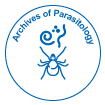Case Report
An Isolated Retrovesical Hydatid Cyst in a Child: A Rare Case Presentation
Nele Alders* and Marek WojciechowskiDepartment of Pediatrics, Antwerp University Hospital, University of Antwerp, Wilrijkstraat 10, 2650, Edegem, Belgium
- *Corresponding Author:
- Nele Alders
Department of Pediatrics, Antwerp University Hospital
University of Antwerp, Wilrijkstraat 10, 2650, Edegem, Belgium
Tel: 0032 3 821 5323
E-mail: nele.alders@uza.be
Received date: May 07, 2017; Accepted date: May 26, 2017; Published date: May 31, 2017
Citation: Alders N, Wojciechowski M (2017) An Isolated Retrovesical Hydatid Cyst in a Child: A Rare Case Presentation. Arch Parasitol 1:103.
Copyright: © 2017 Alders N. This is an open-access article distributed under the terms of the Creative Commons Attribution License, which permits unrestricted use, distribution, and reproduction in any medium, provided the original author and source are credited.
Abstract
Hydatid disease is a parasitic infection caused by Echinococcus granulosus. The most common locations of infection are the liver and lungs. This case discusses a rare isolated retrovesical hydatid cyst. The case-report describes a thirteen year old boy who presented with abdominal pain and dysuria. Ultrasound and magnetic resonance imaging demonstrated a multiloculair cyst, pathognomonic for a hydatid cyst. The retrovesical location caused a unilateral renal hydronephrosis. A renogram showed a right sided afunctional kidney due to this compression. Treatment with albendazol was started but the proposed surgery was refused. There are three possible routes of transmission: the first one is fissuring or rupture of a primary hepatic, splenic or mesenteric cyst with seeding of the content in the abdominal cavity. A second possibility is hematogenous or lymphatic dissemination. The third hypothesis, which we assume is the most probable in this case, is migration through the haemorrhoidal vessels of the rectal ampulla to achieve a retrovesical location.

 Spanish
Spanish  Chinese
Chinese  Russian
Russian  German
German  French
French  Japanese
Japanese  Portuguese
Portuguese  Hindi
Hindi